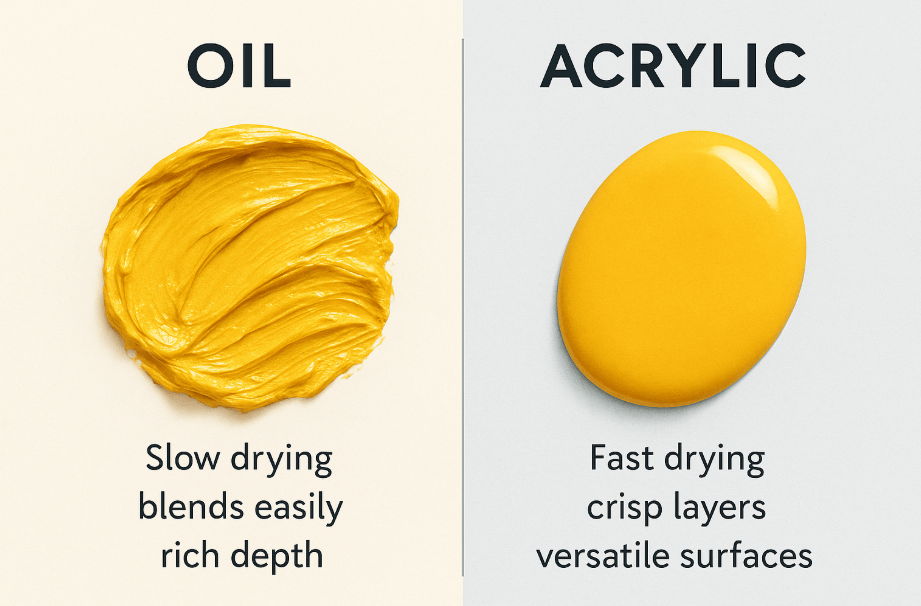Choosing the Right Medium for Your Art

Drying Time and Working Pace
The most striking difference between oils and acrylics is drying time. Acrylic paint dries remarkably quickly – often within minutes for thin layers, and usually within an hour for thicker applications. This makes it ideal for artists who enjoy building layers rapidly or who work in a fast, energetic style. The flip side is that acrylics offer little time for on-canvas blending before the paint begins to set.
Oil paint, by contrast, is slow-drying. Depending on thickness, climate, and medium used, oils can take days, weeks, or even months to dry fully. This leisurely pace allows for subtle blending, soft transitions, and reworking areas long after they were first applied. Many portrait and landscape painters value this quality for achieving realistic effects. However, the longer drying time can be frustrating if you prefer immediate results or need to deliver work quickly.
Surfaces and Preparation
Both oils and acrylics can be applied to canvas, paper, wood, and other surfaces, but there are important distinctions in preparation.
Acrylics are versatile in that they can be applied directly to most primed surfaces and even some unprimed ones. They do not contain oil, so they will not degrade paper or untreated canvas over time. Many acrylic artists work on acrylic-primed canvas or heavy watercolour paper without additional preparation.
Oils, however, require a properly primed surface to prevent the natural oils from rotting the fibres of the canvas or paper. Traditionally, artists use a gesso or oil primer to create a barrier. Linen is a favoured support for oil painting due to its durability, but cotton canvas is also widely used. Skipping proper priming in oils risks long-term damage to your work.
Blending and Texture
When it comes to blending, oils have the advantage. Their slow drying time allows for effortless gradations of tone and colour. You can move paint around for hours, even days, creating the kind of soft edges and nuanced shifts that are difficult to achieve with fast-drying mediums.
Acrylics, while less forgiving in blending, offer opportunities for crisp, graphic edges and bold layering. Modern acrylic mediums can extend open time, allowing more blending, but it rarely matches the ease of oils. Acrylics are also well-suited to texture work, as their quick drying supports the building of multiple thick layers without long waits.
Colour and Finish
Oils are known for their depth of colour and luminous finish. The pigment is suspended in oil, which refracts light in a way that enhances richness and subtlety. Many masterpieces of the past owe their enduring vibrancy to the properties of oil paint.
Acrylics, though historically criticised for a flatter appearance, have improved significantly in recent decades. High-quality artist-grade acrylics offer excellent pigmentation and a wide range of finishes, from matte to glossy. Acrylic colours may darken slightly as they dry, while oils tend to retain their wet appearance.
Longevity and Care
Properly cared for, both mediums can last generations, but oils have a centuries-long track record in galleries and museums. Acrylics are relatively newer, having been developed in the mid-20th century, so their ultimate longevity is still being observed. However, they are stable, flexible, and resistant to cracking, making them well-suited to changing environments.
Oils, once dry, form a hard yet somewhat brittle film, meaning they can crack if painted on a surface that flexes or if exposed to rapid temperature changes. They also require varnishing to protect the surface and maintain vibrancy over time. Acrylics, on the other hand, do not necessarily require varnish, though many artists apply one for protection.
Clean-Up and Health Considerations
Cleaning acrylics is straightforward – they are water-based and can be washed out of brushes with soap and water before they dry. Oils require solvents such as turpentine or white spirit for cleaning, though modern odourless and less toxic options are available. Some artists find acrylics preferable in shared or poorly ventilated spaces for this reason.
Oils also involve working with mediums that may have fumes, so good ventilation is important. Acrylics are generally low-odour, though certain additives and mediums can still produce smells.
Choosing Your Medium
The decision between oils and acrylics comes down to your artistic priorities:
- If you value speed, convenience, and versatility, acrylics may suit you best.
- If you prioritise blending, depth, and traditional richness, oils might be the better choice.
- Some artists use both, employing acrylics for underpainting (because they dry quickly) and finishing with oils for depth and detail – a method that combines the strengths of each.
In the end, the best way to decide is to try both. Every artist has unique preferences, and the medium that feels most natural in your hands will likely bring out your best work. Whether you choose the quick adaptability of acrylics or the timeless elegance of oils, mastering your chosen paint will open endless creative possibilities.
🌟 Welcome back, Abbie Shores!
Want to share something new with the community? You can:
- ✍️ Submit a Magazine Article
- 💬 Join the Forum Chat
- 📬 Check Your Inbox
- Share this link with your friends if you enjoyed the post 🙂 See the share buttons below

